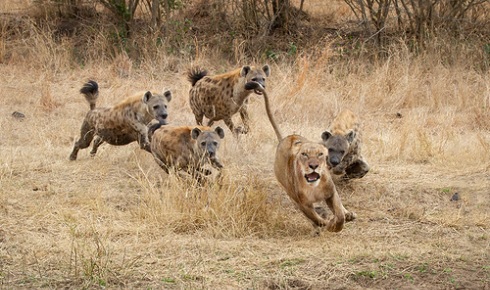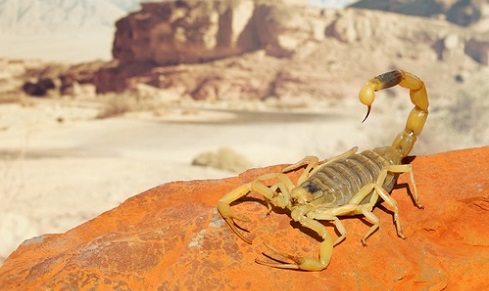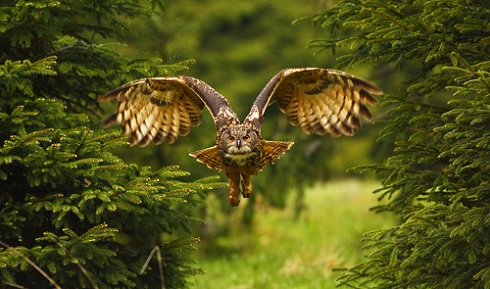A dog eat dog world

Owls eating other owls, coyotes eating foxes, and killer whales eating sharks – Richard Pallardy explores when predators become prey
13th December 2021
It was once believed that the dramatic interactions described above were rare – an anomaly in systems where predators typically prey on animals at lower trophic levels. In early conceptions of community interactions, carnivores ate herbivores and were only incidental victims of predation themselves. Interactions between carnivorous species were viewed in terms of competition for resources and occasional direct conflict.
However, investigations by arachnologist Gary Polis and his collaborators in the 1980s showed that scorpions in the deserts of western North America relentlessly preyed on competing spiders. Their research, which built on earlier anecdotal reports and studies of cannibalism in other species, spurred exploration of similar interactions across the animal kingdom.
Research over the last 40 years has demonstrated unequivocally that the linear models of trophic interaction that once predominated were oversimplifications. In fact, nearly all carnivores stand a chance of becoming food to another animal at some point in their life cycle. Trophic levels are not distinct at all, but exist on a gradient.
Polis and colleagues dubbed the phenomenon they observed ‘intraguild predation’, a guild being a group of organisms that share the same resource. Intraguild predation involves organisms that share a common prey also feeding on each other, and may be unidirectional, with one larger predator feeding on a smaller one, or bidirectional, with both predators feeding on each other as opportunity arises.
One study found that up to 87% of animals are involved in intraguild predation, whether as the shared prey or as predators. These interactions are ubiquitous and they don’t just affect the predators themselves: the consequences ripple throughout the ecosystems they inhabit, influencing the populations and distribution of herbivores and plants as well.
Why eat animals that bite back?
The motivations for intraguild predation are complex and vary between organisms. In some cases the herbivorous animals that comprise the majority of the diet of an intraguild predator may be relatively nutrient-poor. Thus more energy is required to hunt and kill a sufficient number of them to maintain optimal condition. Supplementing with a more nutritious but possibly more dangerous predatory prey species on occasion may thus be worth the effort.
For example, a study of marsh-dwelling wolf spiders (Pardosa littoralis), which mostly predate planthoppers (Prokelisia dolus), found that they were able to increase their nitrogen intake by also eating another species of spider (Grammonota sp.) and a plant bug (Tytthus sp.), both of which also ate the planthoppers. This motivation can occur in much larger organisms as well. Killer whales (Orcinus orca) squeeze the calorie-rich livers out of great white sharks (Carcharodon carcharias) – presumably a riskier prey than a seal or sea lion, also favourite foods of sharks. In both cases populations of the shared prey sometimes benefit from the reduction in the populations of the intraguild prey, with more left for the intraguild predator. Indeed, intraguild competition can be considered an extreme case of interference competition in some cases.
 Scorpions in the deserts of western North America relentlessly prey on competing spiders
Scorpions in the deserts of western North America relentlessly prey on competing spidersSo, too, intraguild prey may be consumed in the wake of conflict for resources, as in the case of lions occasionally feeding on hyenas that they have killed in the process of defending or commandeering kills of other prey. Predators may also proactively address threats, either to themselves or their offspring, and consume some portion of the menacing competitor they have defeated.
Sometimes referred to as super-predators, eagle owls (Bubo bubo) are notoriously intolerant of other raptors in their territories and will extirpate them on occasion. There are records of them eating 24 bird of prey species. Rarely, the super-predators become prey themselves to golden eagles (Aquila chrysaetos).
Predation on the young of competing predators is also a common strategy. Lions (Panthera leo) prey on the cubs of leopards (Panthera pardus), African wild dogs (Lycaon pictus) and spotted hyenas (Crocuta crocuta). Sometimes their victims return the favour, taking unattended lion cubs as their own food. Many raptors also prey on each other’s chicks, further incentivising the maintenance of territorial boundaries and thus the potential for other intraguild predation events.
An intraguild prey species may also simply be more conspicuous than a herbivore. Such is thought to be the case with red foxes (Vulpes vulpes), which prey on Arctic foxes (Vulpes lagopus) on the Fennoscandian Peninsula. Both species mainly eat small rodents, but an Arctic fox may be easier for a red fox to spot and run down than a furtive little lemming. So, too, a Ural owl (Strix uralensis) might find it easier to locate and capture a tawny owl (Strix aluco) than an evasive gamebird because of its cousin’s recognisable vocalisations and comparatively ponderous flight.
Unsurprisingly, resource scarcity can amplify the tendency toward intraguild predation. Radio tracking of a nesting great horned owl (Bubo virginianus) pair found that the artificial addition of two young to their existing brood forced the parents to make further ventures in order to find adequate food. The chicks were found to have lost weight as well. One owl ultimately killed and ate a goshawk (Accipiter gentilis) nesting nearby, having previously had no conflicts with it – a likely instance of food stress leading to intraguild predation. Another study found that goshawks, which prefer pigeons and rabbits, increased their consumption of other raptors by nearly 5% in the wake of rabbit and pigeon population declines.
Of course, these factors probably don’t always motivate predators in isolation. Eagle owls, for example, likely aren’t just defending their territories against other raptors. They may also see an easy opportunity for food and swoop in to take it – and be more likely to do so in a time of scant herbivorous prey. Similarly, the predators of the African savannah are probably both eliminating competitors by eating each other’s young and at the same time making use of a vulnerable and easily accessible resource. These interactions are profoundly non-linear and are not always conducive to singular explanations.
 The eagle owl, known as a 'super-predator', has been shown to actually help increase the diversity of raptors in the forests that it prowls
The eagle owl, known as a 'super-predator', has been shown to actually help increase the diversity of raptors in the forests that it prowlsEcosystem effects
The spectacular interactions that characterise intraguild predation events do not occur in a vacuum. In addition to blurring trophic delineations, they create cascading effects that influence the survival and fitness of every organism in the shared environment.
Firstly, intraguild prey – usually smaller predators – utilise their environments in different temporal and spatial ways when they share them with intraguild predators. They may hunt when their aggressors are at rest, for example. One study found that sharp-shinned hawks (Accipiter striatus) used a small sliver of time during the early morning hours to hunt, thus avoiding possible predation by various owls and by larger Cooper’s hawks (Accipiter cooperii). (Despite this tactic, half of the subjects had been eaten by other raptors by the end of the project.)
Cheetahs (Acinonyx jubatus) tend to hunt at midday, potentially minimising interactions with nocturnal or crepuscular predators such as lions and hyenas that might steal their prey – or eat them. Conversely, wolf spiders (family Lycosidae), which have not adapted the times at which they hunt, are consumed in large numbers by the lesser hairy-footed dunnart (Sminthopsis youngsoni), a competing insectivore.
Animals at risk of intraguild predation may also use suboptimal habitat, with fewer or less favourable prey items, in an effort to avoid becoming prey themselves. In the Santa Monica Mountains of California, grey foxes (Urocyon cinereoargenteus) are restricted to scrubland despite the preference of the species to exploit both open and brushy habitats. They are intensively preyed upon by coyotes in the region and so are forced to exploit the one possible ecotype that is less utilised by its predator. Similarly, African wild dogs avoid regions that are rich in their favoured prey, impala (Aepyceros melampus), in South Africa’s Kruger National Park because they are also favoured by lions, which are responsible for over 40% of deaths in adult dogs.
Unfortunate though these effects may be for the intraguild prey, they benefit ecosystems as a whole. The removal of apex predators, which frequently prey on other carnivores, can result in a phenomenon known as mesopredator release.
When wolves were wiped out in the western United States, coyote populations exploded with deleterious effects on other small predators. Following wolf reintroduction in the 1990s, coyote densities fell, allowing the populations of smaller predators to rebound. Some herbivore populations grew as well: pronghorn antelope calf survival increased when coyote predation pressure was eased.
The misinterpretation of this phenomenon facilitated a campaign to reduce the cownose ray (Rhinoptera bonasus) population on the east coast of North America, which had supposedly exploded in the wake of the removal of larger sharks and decimated oyster populations. Though plausible, further research revealed that these findings were inaccurate and that the species was not capable of increasing its numbers on such a scale. Rather, the misleading conclusions had been used to justify the killing of rays in an effort to optimise hauls of the molluscs it preys on.
In general, though, intraguild interactions do exert a positive effect. Even the eagle owl, indiscriminate super-predator that it is, has been shown to help increase the diversity of raptors in the forests that it prowls. By taking out a few juicy medium-sized owls and hawks, it carves out space for its more diminutive brethren. Much remains to be discovered about how these bloody interactions affect the flow of energy through ecosystems and to what extent. But it is ever clearer that predator is a relative term, easily inverted.
Richard Pallardy is a writer, researcher and editor with a particular interest in zoology, botany, evolution and conservation.
2) Aunapuu, M. et al. Intraguild predation and interspecific co-existence between predatory endotherms. Evol. Ecol. Res. 12(2), 151–168 (2010).
3) Holt, R. D. & Huxel, G. R. Alternative prey and the dynamics of intraguild predation: theoretical perspectives. Ecology 88(11), 2706–2712 (2007).
4) Lindeman, R. L. The trophic-dynamic aspect of ecology. Ecology 23(4), 399–417 (1942).
5) Lourenço, R. et al. Lethal interactions among vertebrate top predators: a review of concepts, assumptions and terminology. Biol. Rev. 89, 270–283 (2014).
6) Polis, G. A. & Farley, R. D. Population biology of a desert scorpion: survivorship, microhabitat, and the evolution of life history strategy. Ecology 61(3), 620–629 (1980).
7) Polis, G. A. & McCormick, S. Scorpions, spiders and solpugids: predation and competition among distantly related taxa. Oecologia 71, 111–116 (1986).
8) Preisser, E. Trophic structure. Encyclopedia of Ecology (Second Edition), 647–655 (2008).
9) Sergio, F. & Hiraldo, F. Intraguild predation in raptor assemblages: a review. IBIS 150(1), 132–145 (2008).


